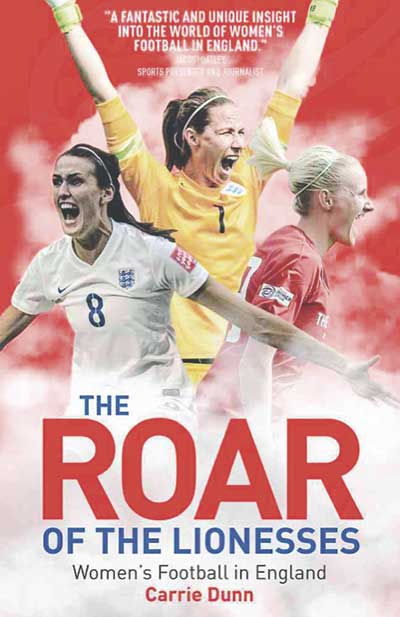
Pitch Publishing, £9.99
Reviewed by Catherine Etoe
From WSC 360, February 2017
Buy this book
Fixture congestion, kick-offs switched to suit broadcasters, an influx of agents, poorer clubs battling to compete; to some supporters, that’s football in England all over. Except that in 2016, such irritations are not only the preserve of the men’s game, they seem to have crept into women’s football too, if The Roar Of The Lionesses is anything to go by.
It comes as some surprise that this latest addition to a growing women’s football canon should throw up such uncomfortable truths. At first glance, with its cut-outs of thrusting internationals and a shouty ROAR on the cover, it looks like a 256-page paean to England’s third-place Women’s World Cup stars of 2015.
Right enough, author Carrie Dunn kicks off with that World Cup high, its immediate impact on the English Women’s Super League (WSL) and the first Women’s FA Cup at Wembley Stadium; attendance records are set, media interest is high, history is made. Yet while Dunn details how far the game has come since the 1921 ban on women playing in FA-affiliated grounds, and what can be achieved by professional women footballers given the right investment and attention, this is actually a far more ambitious project.
For, having spent a year unearthing the stories and experiences of teams, players, fans, managers and administrators from the grassroots up, Dunn uses the fruits of her extensive research to examine the state of play in the women’s game across the board. The result is a blend of the inspirational, the aspirational and the downright irritated.
The backers of historic women’s club Doncaster Rovers Belles have ambitious plans to build their own training facility; Sheffield Ladies battle to compete financially as one of the few WSL clubs not backed by a professional men’s club; Arsenal players celebrate not having to hang around in coffee shops until the men have finished at London Colney because they now have a base of their own there.
Elsewhere, fans gripe about match schedules; administrators fret about funding, managers about agents, others about home grounds that are far from home; and West Ham Ladies’ new chairman worries about finding the passwords to the club’s social media accounts and the keys to the minibus. So while England’s Lionesses, the WSL and the FA’s ambitions are the glue that binds the whole, Dunn also shines a light on the lesser-known individuals.
It helps that she plumps up their stories of grit, determination, promotion and consolidation with an array of facts, mini match reports and a literary flourish (you’ll probably want to attend a match at Aggborough just to breathe in the blend of freshly mown grass mixed with the smoke of nearby steam trains).
Not all the stories hit home, in particular the crowdfunding attempts of the GB Deaf Women’s Football team feels shoehorned in, while the few photos included might struggle to make it into a football version of Crap Towns. But by both championing and questioning the women’s game, this accomplished book does it a great service.